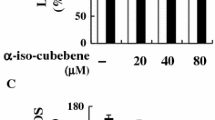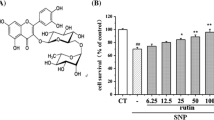Abstract
Our previous work demonstrated that tetrahydroxystilbene glucoside (TSG) was able to effectively attenuate 1-methyl-4-phenylpyridinium (MPP+)-induced apoptosis in PC12 cells partially via inhibiting reactive oxygen species (ROS) generation. However, the precise molecular mechanisms of TSG responsible for suppressing neuronal apoptosis have not been fully elucidated. To investigate the possible mechanism, we studied the neuroprotective effects of TSG on MPP+-induced PC12 cells apoptosis and explored the molecular mechanisms that mediated the effects of TSG. Our results showed that treatment with TSG prior to MPP+ exposure effectively attenuated the cell viability decrease in PC12 cells, reversed the cell apoptosis, and further restored the mitochondria membrane potential (MMP). In addition, TSG remarkably enhanced the anti-oxidant enzyme activities of superoxide dismutase (SOD), catalase (CAT), and glutathione peroxidase (GSH-Px), and efficiently reduced the malondialdehyde (MDA) content in the PC12 cells. Meanwhile, TSG markedly upregulated the Bcl-2/Bax ratio, reversed release of Cytochrome c, and inhibited the activation of caspase-3 induced by MPP+. Furthermore, TSG significantly inhibited the activation of p38 mitogen-activated protein kinase (p38MAPK) signaling pathway, while extracellular signal-regulated protein kinases (ERK) phosphorylation was not affected. Together, these findings provide the basis for TSG clinical application as a new therapeutic strategy in the treatment of neurodegenerative diseases.








Similar content being viewed by others
References
Lees AJ, Hardy J, Revesz T (2009) Parkinson’s disease. Lancet 373:2055–2066
Yacoubian TA, Standaert DG (2009) Targets for neuroprotection in Parkinson’s disease. Biochim Biophys Acta 1792:676–687
Zhou C, Huang Y, Przedborski S (2008) Oxidative stress in Parkinson’s disease: a mechanism of pathogenic and therapeutic significance. Ann N Y Acad Sci 1147:93–104
Halliwell B, Aruoma OI (1991) DNA damage by oxygen-derived species. Its mechanism and measurement in mammalian systems. FEBS Lett 281:9–19
Wang S, He H, Chen L, Zhang W, Zhang X, Chen J (2015) Protective effects of salidroside in the MPTP/MPP (+)-induced model of Parkinson’s disease through ROS-NO-related mitochondrion pathway. Mol Neurobiol 51:718–728
Kuo HC, Lu CC, Shen CH, Tung SY, Hsieh MC, Lee KC, Lee LY, Chen CC, Teng CC, Huang WS, Chen TC, Lee KF (2016) Hericium erinaceus mycelium and its isolated erinacine A protection from MPTP-induced neurotoxicity through the ER stress, triggering an apoptosis cascade. J Transl Med 14:78
Lotharius J, O’Malley KL (2000) The parkinsonism-inducing drug 1-methyl-4-phenylpyridinium triggers intracellular dopamine oxidation. A novel mechanism of toxicity. J Biol Chem 275:38581–38588
Cassarino DS, Parks JK, Parker WD Jr, Bennett JP Jr (1999) The parkinsonian neurotoxin MPP+ opens the mitochondrial permeability transition pore and releases cytochrome c in isolated mitochondria via an oxidative mechanism. Biochim Biophys Acta 1453:49–62
Rebois RV, Reynolds EE, Toll L, Howard BD (1980) Storage of dopamine and acetylcholine in granules of PC12, a clonal pheochromocytoma cell line. Biochemistry 19:1240–1248
Bournival J, Quessy P, Martinoli MG (2009) Protective effects of resveratrol and quercetin against MPP+-induced oxidative stress act by modulating markers of apoptotic death in dopaminergic neurons. Cell Mol Neurobiol 29:1169–1180
Maghsoudi A, Fakharzadeh S, Hafizi M, Abbasi M, Kohram F, Sardab S, Tahzibi A, Kalanaky S, Nazaran MH (2015) Neuroprotective effects of three different sizes nanochelating based nano complexes in MPP (+) induced neurotoxicity. Apoptosis 20:298–309
Qin R, Li X, Li G, Tao L, Li Y, Sun J, Kang X, Chen J (2011) Protection by tetrahydroxystilbene glucoside against neurotoxicity induced by MPP+: the involvement of PI3K/Akt pathway activation. Toxicol Lett 202:1–7
Chan YC, Cheng FC, Wang MF (2002) Beneficial effects of different Polygonum multiflorum Thunb. extracts on memory and hippocampus morphology. J Nutr Sci Vitaminol (Tokyo) 48:491–497
Yao S, Li Y, Kong L (2006) Preparative isolation and purification of chemical constituents from the root of Polygonum multiflorum by high-speed counter-current chromatography. J Chromatogr A 1115:64–71
Li X, Li Y, Chen J, Sun J, Li X, Sun X, Kang X (2010) Tetrahydroxystilbene glucoside attenuates MPP+-induced apoptosis in PC12 cells by inhibiting ROS generation and modulating JNK activation. Neurosci Lett 483:1–5
Zhang YZ, Shen JF, Xu JY, Xiao JH, Wang JL (2007) Inhibitory effects of 2,3,5,4′-tetrahydroxystilbene-2-O-beta-d-glucoside on experimental inflammation and cyclooxygenase 2 activity. J Asian Nat Prod Res 9:355–363
Zhou X, Yang Q, Xie Y, Sun J, Hu J, Qiu P, Cao W, Wang S (2015) Tetrahydroxystilbene glucoside extends mouse life span via upregulating neural klotho and downregulating neural insulin or insulin-like growth factor 1. Neurobiol Aging 36:1462–1470
Wang T, Gu J, Wu PF, Wang F, Xiong Z, Yang YJ, Wu WN, Dong LD, Chen JG (2009) Protection by tetrahydroxystilbene glucoside against cerebral ischemia: involvement of JNK, SIRT1, and NF-κB pathways and inhibition of intracellular ROS/RNS generation. Free Radic Biol Med 47:229–240
Song F, Zhao J, Hua F, Nian L, Zhou XX, Yang Q, Xie YH, Tang HF, Sun JY, Wang SW (2015) Proliferation of rat cardiac stem cells is induced by 2, 3, 5, 4′-tetrahydroxystilbene-2-O-β-d-glucoside in vitro. Life Sci 132:68–76
Sun FL, Zhang L, Zhang RY, Li L (2011) Tetrahydroxystilbene glucoside protects human neuroblastoma SH-SY5Y cells against MPP+-induced cytotoxicity. Eur J Pharmacol 660:283–290
Zhang L, Huang L, Chen L, Hao D, Chen J (2013) Neuroprotection by tetrahydroxystilbene glucoside in the MPTP mouse model of Parkinson’s disease. Toxicol Lett 222:155–163
He H, Wang S, Tian J, Chen L, Zhang W, Zhao J, Tang H, Zhang X, Chen J (2015) Protective effects of 2,3,5,4′-tetrahydroxystilbene-2-O-β-d-glucoside in the MPTP-induced mouse model of Parkinson’s disease: involvement of reactive oxygen species-mediated JNK, P38 and mitochondrial pathways. Eur J Pharmacol 767:175–182
Yang YW, Wu CA, Morrow WJ (2004) The apoptotic and necrotic effects of tomatine adjuvant. Vaccine 22:2316–2327
Hu XL, Niu YX, Zhang Q, Tian X, Gao LY, Guo LP, Meng WH, Zhao QC (2015) Neuroprotective effects of Kukoamine B against hydrogen peroxide-induced apoptosis and potential mechanisms in SH-SY5Y cells. Environ Toxicol Pharmacol 40:230–240
Bass DA, Parce JW, Dechatelet LR, Szejda P, Seeds MC, Thomas M (1983) Flow cytometric studies of oxidative product formation by neutrophils: a graded response to membrane stimulation. J Immunol 130:1910–1917
Zamzami N, Kroemer G (2004) Methods to measure membrane potential and permeability transition in the mitochondria during apoptosis. Methods Mol Biol 282:103–115
Mignotte B, Vayssiere JL (1998) Mitochondria and apoptosis. Eur J Biochem 252:1–15
Hengartner MO (2000) The biochemistry of apoptosis. Nature 407:770–776
Toulouse A, Sullivan AM (2008) Progress in Parkinson’s disease—where do we stand? Prog Neurobiol 85:376–392
Chen LW, Wang YQ, Wei LC, Shi M, Chan YS (2007) Chinese herbs and herbal extracts for neuroprotection of dopaminergic neurons and potential therapeutic treatment of Parkinson’s disease. CNS Neurol Disord Drug Targets 6:273–281
Heng Y, Zhang QS, Mu Z, Hu JF, Yuan YH, Chen NH (2016) Ginsenoside Rg1 attenuates motor impairment and neuroinflammation in the MPTP-probenecid-induced parkinsonism mouse model by targeting α-synuclein abnormalities in the substantia nigra. Toxicol Lett 243:7–21
Kumar H, Lim HW, More SV, Kim BW, Koppula S, Kim IS, Choi DK (2012) The role of free radicals in the aging brain and Parkinson’s disease: convergence and parallelism. Int J Mol Sci 13:10478–10504
Kroemer G, Galluzzi L, Brenner C (2007) Mitochondrial membrane permeabilization in cell death. Physiol Rev 87:99–163
Exner N, Lutz AK, Haass C, Winklhofer KF (2012) Mitochondrial dysfunction in Parkinson’s disease: molecular mechanisms and pathophysiological consequences. EMBO J 31:3038–3062
Ola MS, Nawaz M, Ahsan H (2011) Role of Bcl-2 family proteins and caspases in the regulation of apoptosis. Mol Cell Biochem 351:41–58
Hartmann A, Hunot S, Michel PP, Muriel MP, Vyas S, Faucheux BA, Mouatt-Prigent A, Turmel H, Srinivasan A, Ruberg M, Evan GI, Agid Y, Hirsch EC (2000) Caspase-3: a vulnerability factor and final effector in apoptotic death of dopaminergic neurons in Parkinson’s disease. Proc Natl Acad Sci USA 97:2875–2880
Eguchi M, Monden K, Miwa N (2003) Role of MAPK phosphorylation in cytoprotection by pro-vitamin C against oxidative stress-induced injuries in cultured cardiomyoblasts and perfused rat heart. J Cell Biochem 90:219–226
Chang L, Karin M (2001) Mammalian MAP kinase signaling cascades. Nature 410:37–40
Irving EA, Bamford M (2002) Role of mitogen- and stress-activated kinases in ischemic injury. J Cereb Blood Flow Metab 22:631–647
Zhu X, Lee HG, Raina AK, Perry G, Smith MA (2002) The role of mitogen-activated protein kinase pathways in Alzheimer’s disease. Neurosignals 11:270–281
Zhai A, Zhu X, Wang X, Chen R, Wang H (2013) Secalonic acid A protects dopaminergic neurons from 1-methyl-4-phenylpyridinium (MPP+)-induced cell death via the mitochondrial apoptotic pathway. Eur J Pharmacol 713:58–67
Acknowledgements
This work was supported by grants from the National Natural Science Foundation of China (No. 81371411 and 81173590).
Author information
Authors and Affiliations
Corresponding authors
Ethics declarations
Conflict of interest
The authors declare that they have no conflict of interest.
Rights and permissions
About this article
Cite this article
Zhang, L., Huang, L., Li, X. et al. Potential molecular mechanisms mediating the protective effects of tetrahydroxystilbene glucoside on MPP+-induced PC12 cell apoptosis. Mol Cell Biochem 436, 203–213 (2017). https://doi.org/10.1007/s11010-017-3169-8
Received:
Accepted:
Published:
Issue Date:
DOI: https://doi.org/10.1007/s11010-017-3169-8




